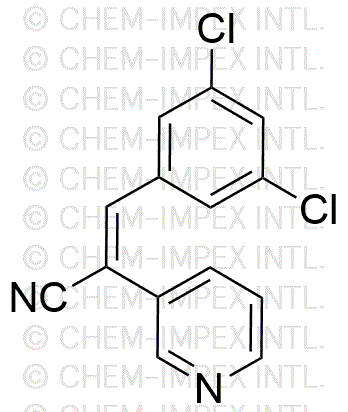Tyrphostin RG 14620 is widely utilized in research focused on:
- Cancer Research: This compound is known for its ability to inhibit specific tyrosine kinases, making it a valuable tool in studying cancer cell signaling pathways and potential treatments.
- Neuroscience: Researchers use it to explore the role of tyrosine kinases in neuronal signaling, which can lead to advancements in understanding neurodegenerative diseases.
- Drug Development: Its properties allow scientists to develop targeted therapies that can minimize side effects compared to traditional chemotherapy, enhancing patient outcomes.
- Cell Biology: It serves as a critical reagent in experiments designed to dissect cellular processes, particularly those involving growth factor signaling.
- Pharmaceutical Formulations: The compound's unique structure can be leveraged in creating innovative drug formulations, potentially improving bioavailability and efficacy.
Informations générales
Propriétés
Sécurité et réglementation
Applications
Tyrphostin RG 14620 is widely utilized in research focused on:
- Cancer Research: This compound is known for its ability to inhibit specific tyrosine kinases, making it a valuable tool in studying cancer cell signaling pathways and potential treatments.
- Neuroscience: Researchers use it to explore the role of tyrosine kinases in neuronal signaling, which can lead to advancements in understanding neurodegenerative diseases.
- Drug Development: Its properties allow scientists to develop targeted therapies that can minimize side effects compared to traditional chemotherapy, enhancing patient outcomes.
- Cell Biology: It serves as a critical reagent in experiments designed to dissect cellular processes, particularly those involving growth factor signaling.
- Pharmaceutical Formulations: The compound's unique structure can be leveraged in creating innovative drug formulations, potentially improving bioavailability and efficacy.
Documents
Fiches de données de sécurité (FDS)
La FDS fournit des informations de sécurité complètes sur la manipulation, le stockage et l’élimination du produit.
Spécifications du produit (PS)
Le PS fournit une description complète des propriétés du produit, notamment sa composition chimique, son état physique, sa pureté et les exigences de stockage. Il détaille également les plages de qualité acceptables et les applications prévues du produit.
Certificats d'analyse (COA)
Recherchez des certificats d'analyse (COA) en saisissant le numéro de lot du produit. Les numéros de lot et de lot se trouvent sur l'étiquette d'un produit, après les mots « Lot » ou « Lot de fabrication ».
Numéro de catalogue
Numéro de lot/série
Certificats d'origine (COO)
Ce certificat d'exploitation confirme le pays dans lequel le produit a été fabriqué, et détaille également les matériaux et composants utilisés et s'il est issu de sources naturelles, synthétiques ou autres sources spécifiques. Ce certificat peut être requis pour les douanes, le commerce et la conformité réglementaire.
Numéro de catalogue
Numéro de lot/série
Fiches de données de sécurité (FDS)
La FDS fournit des informations de sécurité complètes sur la manipulation, le stockage et l’élimination du produit.
DownloadSpécifications du produit (PS)
Le PS fournit une description complète des propriétés du produit, notamment sa composition chimique, son état physique, sa pureté et les exigences de stockage. Il détaille également les plages de qualité acceptables et les applications prévues du produit.
DownloadCertificats d'analyse (COA)
Recherchez des certificats d'analyse (COA) en saisissant le numéro de lot du produit. Les numéros de lot et de lot se trouvent sur l'étiquette d'un produit, après les mots « Lot » ou « Lot de fabrication ».
Numéro de catalogue
Numéro de lot/série
Certificats d'origine (COO)
Ce certificat d'exploitation confirme le pays dans lequel le produit a été fabriqué, et détaille également les matériaux et composants utilisés et s'il est issu de sources naturelles, synthétiques ou autres sources spécifiques. Ce certificat peut être requis pour les douanes, le commerce et la conformité réglementaire.


